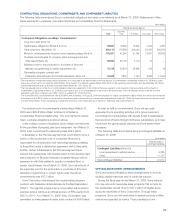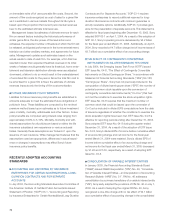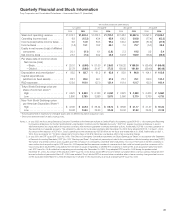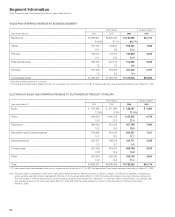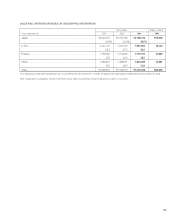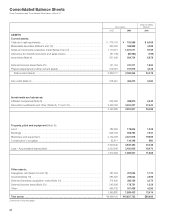Sony 2006 Annual Report Download - page 76
Download and view the complete annual report
Please find page 76 of the 2006 Sony annual report below. You can navigate through the pages in the report by either clicking on the pages listed below, or by using the keyword search tool below to find specific information within the annual report.74
included ¥8.5 billion for the impairment of long-lived assets of
the Metreon, an entertainment complex to be held for sale in the
U.S. in connection with restructuring activities of non-core
businesses in All Other. The impairment charge was based on
the negotiated sales price of the complex.
■GOODWILL AND OTHER INTANGIBLE ASSETS
Goodwill and other intangible assets that are determined to have
an indefinite life are not amortized, but are tested for impairment
in accordance with FAS No. 142 during the fourth quarter of
fiscal year on an annual basis and between annual tests if an
event occurs or circumstances change that would more likely
than not reduce the fair value of these assets below their
carrying amount. Such an event would include unfavorable
variances from established business plans, significant changes
in forecasted results or volatility inherent to external markets and
industries, which are periodically reviewed by management.
Specifically, goodwill impairment is determined using a two-step
process. The first step of the goodwill impairment test is used to
identify potential impairment by comparing the fair value of a
reporting unit (Sony’s operating segments or one level below
the operating segments) with its carrying amount, including
goodwill. If the fair value of a reporting unit exceeds its carrying
amount, goodwill of the reporting unit is considered not impaired
and the second step of the impairment test is unnecessary. If
the carrying amount of a reporting unit exceeds its fair value, the
second step of the goodwill impairment test is performed to
measure the amount of impairment loss, if any. The second step
of the goodwill impairment test compares the implied fair value
of the reporting unit’s goodwill with the carrying amount of that
goodwill. If the carrying amount of the reporting unit’s goodwill
exceeds the implied fair value of that goodwill, an impairment
loss is recognized in an amount equal to that excess. The
implied fair value of goodwill is determined in the same manner
as the amount of goodwill recognized in a business combina-
tion. That is, the fair value of the reporting unit is allocated to all
of the assets and liabilities of that unit (including any unrecog-
nized intangible assets) as if the reporting unit had been
acquired in a business combination and the fair value of the
reporting unit was the purchase price paid to acquire the
reporting unit. Other intangible assets are tested for impairment
by comparing the fair value of the intangible asset with its
carrying value. If the carrying value of the intangible asset
exceeds its fair value, an impairment loss is recognized in an
amount equal to that excess.
Determining the fair value of a reporting unit under the first
step of the goodwill impairment test and determining the fair
value of individual assets and liabilities of a reporting unit
(including unrecognized intangible assets) under the second
step of the goodwill impairment test is judgmental in nature and
often involves the use of significant estimates and assumptions.
Similarly, estimates and assumptions are used in determining the
fair value of other intangible assets. These estimates and
assumptions could significantly impact whether or not an
impairment charge is recognized as well as the magnitude of
any such charge. In its impairment review, Sony performs
internal valuation analyses or utilizes third-party valuations when
management believes it to be appropriate, and considers other
market information that is publicly available. Estimates of fair
value are primarily determined using discounted cash flow
analysis. This approach uses significant estimates and assump-
tions including projected future cash flows, the timing of such
cash flows, discount rates reflecting the risk inherent in future
cash flows, perpetual growth rates, determination of appropriate
market comparables and the determination of whether a
premium or discount should be applied to comparables. During
the fourth quarter of the year ended March 31, 2006, Sony
performed the annual impairment test for goodwill and recorded
an impairment loss of ¥0.5 billion in a reporting unit in All Other.
This impairment charge reflected the overall decline in the fair
value of a subsidiary. The fair value of the subsidiary was
estimated principally using the expected present value of future
cash flows.
Management believes that the estimates of future cash flows
and fair value are reasonable; however, changes in estimates
resulting in lower future cash flows and fair value due to unfore-
seen changes in business assumptions could negatively affect the
valuations, which may result in Sony recognizing impairment
charges for goodwill and other intangible assets in the future. In
order to evaluate the sensitivity of the fair value calculations on the
impairment analysis, Sony applied a hypothetical 10% decrease
to the fair value of each reporting unit. As of March 31, 2006, a
10% hypothetical decrease to the fair value of each reporting
units would not have resulted in a material impairment loss.
■PENSION BENEFITS COSTS
Employee pension benefit costs and obligations are dependent
on certain assumptions including discount rates, retirement
rates and mortality rates, which are based upon current statisti-
cal data, as well as expected long-term rates of return on plan
assets and other factors. Specifically, the discount rate and
expected long-term rate of return on assets are two critical
assumptions in the determination of periodic pension costs and
pension liabilities. Assumptions are evaluated at least annually,
or at the time when events occur or circumstances change and
these events or changes could have a significant effect on these
critical assumptions. In accordance with U.S. GAAP, actual
results that differ from the assumptions are accumulated and
amortized over future periods. Therefore, actual results generally
affect recognized costs and the recorded obligations for pensions



